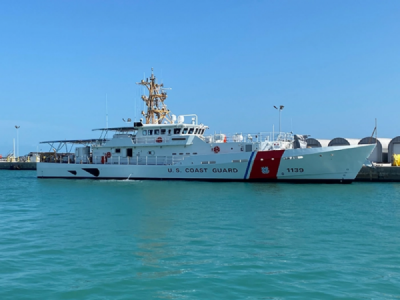
Posted on May 31, 2020
Bollinger Shipyards has delivered the USCGC Myrtle Hazard to the U.S. Coast Guard in Key West, Florida. The Fast Response Cutter (FRC) is the first of three that will be homeported in Apra Harbor, Guam, increasing the Coast Guard’s presence in the Indo-Pacific Theater. Additionally, later this year, Bollinger will be delivering the first of six FRCs that will be homeported in Manama, Bahrain, where they will replace the Island Class Patrol Boats currently supporting the Patrol Forces Southwest Asia, the U. S. Coast Guard’s largest unit outside of the United States.
“Our latest delivery of the USCGC Myrtle Hazard is an important milestone in the FRC Program as it is the first of several vessels that will expand and support the Coast Guard’s operational presence and enhance the U.S.’s mission in the Indo-Pacific region – a focal point emphasized by both President Trump and Admiral Shultz,” said Bollinger President & Ben Bordelon. “Building ships for the U.S. Coast Guard provides critical assets to bolster our national security interests, both domestic and abroad. We are proud and humbled to be partners in the FRC program.”
While the last 12 weeks of the USCGC Myrtle Hazard’s build occurred during the COVID-19 global pandemic, Bollinger undertook precautions to ensure the health and safety of employees and maintain its delivery schedule. In addition to increased and enhanced sanitization practices across the shipyard, Bollinger enacted more liberal leave and remote work policies as well as altered shift schedules to promote social distancing.
“Delivering vessels on schedule and on budget to the Coast Guard in these unprecedented times given the COVID-19 challenges that we are all facing shows the resiliency and dedication of our incredibly capable workforce,” said Bordelon. “The FRC hot production line continues to produce and provide stability in the industrial base for the U.S. Government and our Bollinger workforce, assuring economic benefit for the Lafourche Parish Louisiana region, our vendor partners in the 40-plus states that support the FRC program, and our country.”
Each FRC is named for an enlisted Coast Guard hero who distinguished himself or herself in the line of duty. A young mother in 1918, Myrtle Hazard answered a help-wanted ad for a qualified radio operator after graduating from a radio and telegraphy class at the Baltimore YMCA. Extremely skilled in telegraphy and proficient in Morse code, the Coast Guard enlisted Ms. Hazard on January 21, 1918 and she became the service’s first female electrician. Ms. Hazard worked at U.S. Coast Guard headquarters in Washington, D.C. as an electrician’s mate 3rd class and was later promoted to electrician, 1st class, before being demobilized after the war’s end.
Source: marinelog





